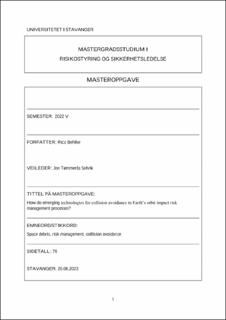| dc.description.abstract | Human society is strongly dependent on satellite-based services such as communication, Earth observation, navigation etc. A by-product of satellite operations is the generation of space debris which consists amongst others of launch stages, defunct satellites, tools or debris resulting from collisions. A collision between an operating spacecraft and space debris can severely damage the operating spacecraft, render it inoperable or in the worst lead to its destruction and many thousands of new pieces of debris. The commercialization of space operations has led to the introduction of thousands of new spacecraft into orbit which provides challenges for collision avoidance operations. Earlier, these have been manual operations, but the sheer number of objects in orbit around the Earth questions if human operators can handle this. Thus, autonomous collision avoidance systems including emerging technologies such as Artificial intelligence have been utilized.
Earlier, for manual collision avoidance operations, classical risk management procedures could be adopted, since the space environment resembled a rather static problem. Now, the orbital picture is much more dynamic with constant manoeuvrers and the change from human to AI operators. Thus, the question arises if the introduction of AI into collision avoidance requires risk management procedures to be revised and the inherent risk of AI operations to be addressed.
This thesis discusses these two issues and concludes that, although AI operations can significantly support collision avoidance features, emerging technologies require modernised risk management approaches with human feedback in order to quality-check the deliveries of the AI and to address the highly dynamic system the AI operates in. Otherwise, AI operations can lead to situations which should have been prevented from the beginning, namely collisions that created even more space debris. This could in the worst case render the orbit around the Earth inoperable. | |
